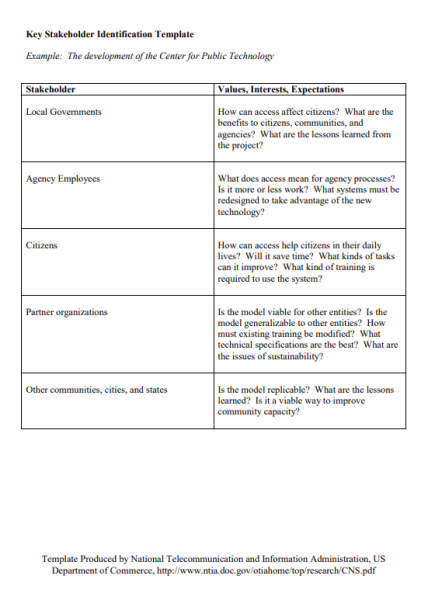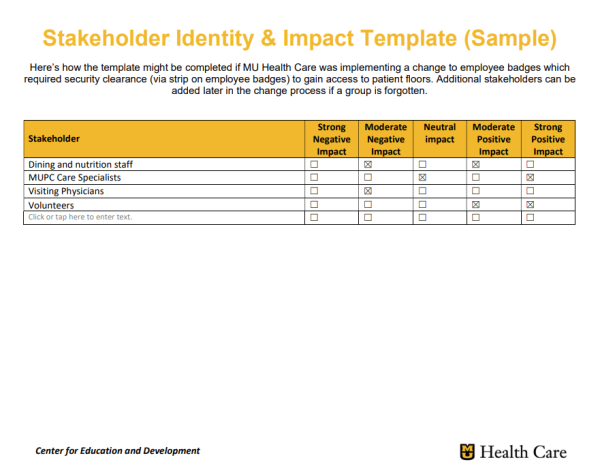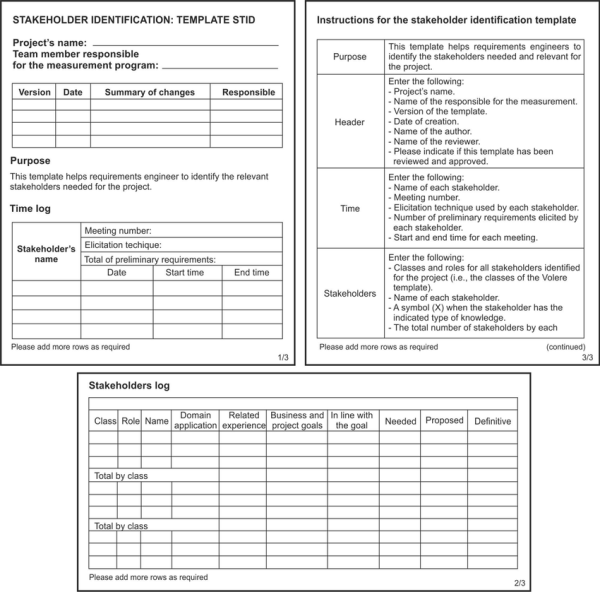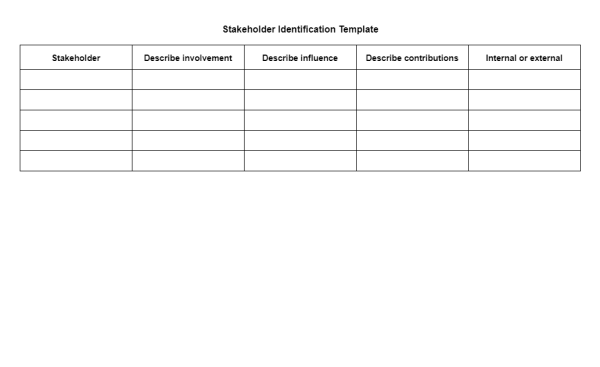The term stakeholder identification refers to the process of identifying the individuals or groups that have a vested interest in an organization or project. This can include shareholders, employees, customers, suppliers, partners, and other interested parties. It is important to identify stakeholders to ensure that all relevant parties are considered during the decision-making process.
This helps to ensure that the final decision is one that is in the best interests of the organization as a whole. Additionally, it can help to identify potential risks and opportunities associated with a particular course of action.
- Why Is Stakeholder Identification Important?
- How To Identify Key Stakeholders
- Stakeholder Identification Template PDF
- Stakeholder Identification Template Word
- Stakeholder Identification Template Google Sheets
- Stakeholder Identification Template PowerPoint
- Stakeholder Identification Template Mind Meister
- Benefits of Stakeholder Identification
- Stakeholder Identification Vs Analysis
- Best Practices
The term stakeholder identification refers to the process of identifying the individuals or groups that have a vested interest in an organization or project. This can include shareholders, employees, customers, suppliers, partners, and other interested parties.
This stakeholder management involves understanding, analyzing, and communicating with stakeholders in order to meet their needs and expectations. If you’re aspiring to become a successful project manager is it super important you understand the concept of Stakeholder.
A stakeholder is anyone who can affect or be affected by an organization or project. In other words, stakeholders are individuals or groups who have a vested interest in the success or failure of a company or initiative.
Why Is Stakeholder Identification Important?
Organizations need to properly identify stakeholders in order for management to be successful. There are a variety of methods that can be used to identify stakeholders, but the most important thing is to ensure that all stakeholders are considered.
Once stakeholders have been identified, it is important to analyze their interests and how they might be impacted by the organization.
This analysis will help determine how to best communicate with and manage each stakeholder.
By following these steps, you can ensure that all stakeholders are considered and that your organization is able to effectively manage them.
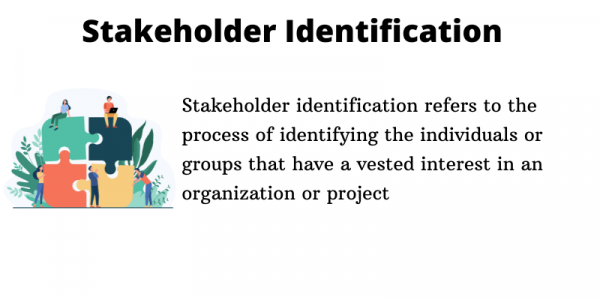
How To Identify Key Stakeholders
There are a few different methods that can be used to identify stakeholders.
The first is to look at who is affected by the organization. This includes looking at who benefits from the organization’s success and who is harmed by its failure.
Another method is to look at who has power over the organization. This includes stakeholders who can make decisions that will impact the organization, such as government regulators.
The third method is to look at who has information that the organization needs. This includes stakeholders who can provide information about the market or the competition.
Understand the organization and its environment
The first step in any stakeholder identification process is to understand the organization and its environment. This will help you to identify which groups or individuals could potentially have an impact on the organization or be affected by its actions.
Gather information on the stakeholders
Next, you will need to identify the specific stakeholders that you will be targeting. This will require you to gather information on the stakeholders, such as their interests, priorities, and influencers.
Prioritize Stakeholder
Once you have gathered this information, you will need to prioritize the stakeholders based on their level of influence and impact. This will help you to focus your efforts on the most important stakeholders.
Develop Engagement Plan
Finally, you will need to develop a plan for engagement with each of the stakeholders. This plan should consider the best way to reach the stakeholders, as well as what type of information or communication will be most effective. Remember, not all stakeholders are equal—some will have more power, more interest, or more influence over the project than others. Just consider the important part that Prioritizing stakeholders will help you decide how to best engage with them and manage their expectations according to their power.
Stakeholder Identification Template PDF
Stakeholder Identification Template Word
Stakeholder Identification Template Google Sheets
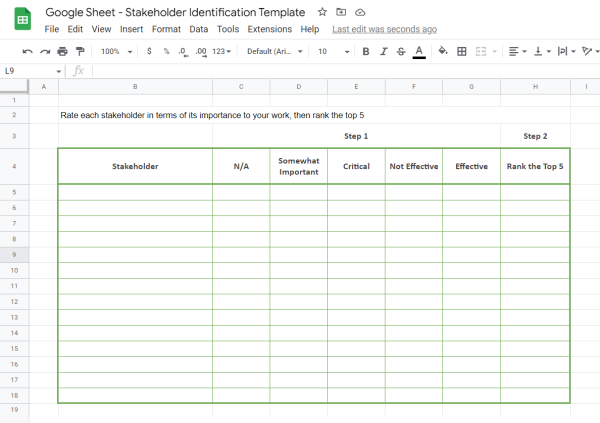
Stakeholder Identification Template PowerPoint
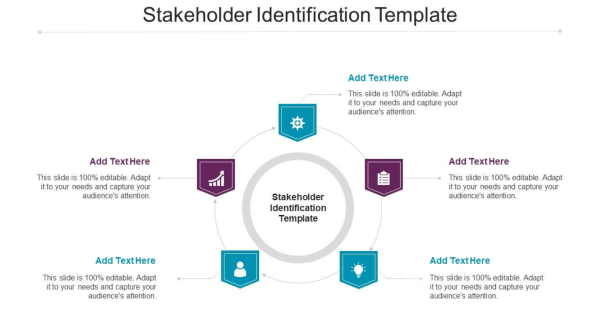
Stakeholder Identification Template Mind Meister
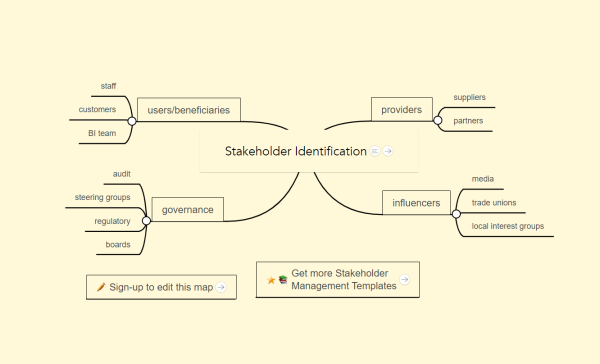
Benefits of Stakeholder Identification
When conducting a stakeholder identification, there are key benefits to consider
- This activity allows for the assessment of all relevant individuals or groups that could impact or be impacted by a project or decision.
- It allows for the development of tailored strategies for engagement with each group.
- Additionally, this process can help to identify potential risks and challenges associated with the project
- It can help you understand who is invested in your project or product, what their interests are, and how best to communicate with them. It can also help you anticipate potential problems and develop strategies to address them.
By taking the time to identify all stakeholders upfront, organizations can save time and resources in the long run.
Stakeholder Identification Vs Analysis
A key difference between stakeholder identification and analysis is the sequence in which it happens.
| Stakeholder Identification | Stakeholder Analysis |
|---|---|
| Stakeholder identification is simply the process of identifying all the stakeholders in a project or business. This can be done through a variety of methods, such as interviews, surveys, and focus groups. | Stakeholder analysis, on the other hand, is a more in-depth process that looks at the interests and needs of each stakeholder. This information is then used to determine how to best engage with each stakeholder. |
| This process of identifying all the individuals and groups who have a stake in the project, includes project sponsors, team members, customers, and anyone else who will be affected by the project. | This process includes their interests, roles, and levels of influence. The goal of stakeholder analysis is to develop a strategy for managing each stakeholder’s impact on the project. |
This process is essential for ensuring that all stakeholders are properly engaged and that their needs are being met
The process of stakeholder identification is important because it helps you to find out who your stakeholders are and what their interests are. While The process of stakeholder analysis is important because it helps you to find out their power and interest
So, to sum it up, stakeholder identification is the first step in engagement, while stakeholder analysis is the next step that ensures that engagement is effective.
Best Practices
There are a number of best practices that you can follow when it comes to identifying and managing your stakeholders. Project managers must identify relevant stakeholders early on in the project development process in order to ensure successful communication and outcomes.
Below are some best practices for stakeholder identification
- Define the project’s objectives and expected outcomes. This will help identify which stakeholders need to be involved in the project in order to achieve its objectives.
- Conduct a stakeholder analysis. This will help you identify which stakeholders have a vested interest in the project and how much influence they have.
- Identify potential risks and issues. This will help you anticipate potential problems and identify the stakeholders who need to be involved in addressing them.
- Develop a communication plan. This will ensure that all stakeholders are kept up-to-date on the project’s progress and that their input is taken into account.
- Another important consideration is how to engage with the stakeholders.
This will vary depending on the stakeholder’s role and level of interest. However, it is generally advisable to keep stakeholders informed and updated on the project’s progress. This can be done through regular communication channels such as email, meetings, or project updates. Following these best practices will help you ensure that you are effectively engaging with your stakeholders and that they are supporting your business goals.
Click here to download the 67+ stakeholder register template
Click here to download 5 free stakeholder analysis template
Click here to download 11 free stakeholder engagement plan template
FAQs
Why It Is Important To Properly Identify Stakeholders?
It is important to properly identify stakeholders because they can have a major impact on the success or failure of an organization. Stakeholders can provide essential resources, such as capital, customers, or suppliers. They can also hinder an organization’s progress by withholding information or using their power to make decisions that are not in the organization’s best interests.
How Can You Keep Stakeholders Engaged?
There are a few different ways to keep stakeholders engaged. The first is to keep them informed about the organization’s progress. This can be done through regular updates, such as progress reports or newsletters.
Another way to keep stakeholders engaged is to solicit their feedback. This can be done through surveys or focus groups. It is important to listen to the feedback and make changes based on what the stakeholders want.
Best Practices For Keeping Stakeholders Engaged
There are a few best practices for keeping stakeholders engaged. The first is to develop a communication plan. This plan should include who will be responsible for communication, how often communication will take place, and what information will be communicated.
Another best practice is to create a stakeholder management plan. This plan should include how the stakeholders will be managed, how their interests will be represented, and how to resolve conflicts.
What is Stakeholder identification?
Stakeholder identification is the process of identifying all the stakeholders in your project. This is important because it helps you to understand all the people are that will be affected by your project and what their interests are. Once you have identified all the stakeholders, you can then prioritize them according to their level of influence and interest.

